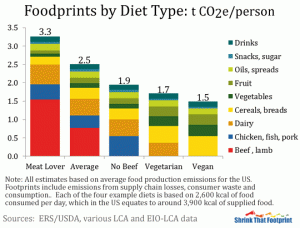 This week’s lesson noted a significant observation among different global class demographics in relation to their ecological footprint and dietary trends. The global poor contribute about 2% of all greenhouse gas emissions. Yet, the global rich contribute about 80% of global greenhouse gas emissions. This greenhouse gas issue stems from the differences in diets depending on people’s wealth. Poorer people often rely on diets consisting of grains, tubers, little meat, and water. However, wealthier people have developed diets heavily surrounding red meats, processed foods, and sugary soft drinks. These components that exists in many affluent diets contribute to greenhouse gas emissions due to the resources used to transport them from their agricultural stage to retail.
This week’s lesson noted a significant observation among different global class demographics in relation to their ecological footprint and dietary trends. The global poor contribute about 2% of all greenhouse gas emissions. Yet, the global rich contribute about 80% of global greenhouse gas emissions. This greenhouse gas issue stems from the differences in diets depending on people’s wealth. Poorer people often rely on diets consisting of grains, tubers, little meat, and water. However, wealthier people have developed diets heavily surrounding red meats, processed foods, and sugary soft drinks. These components that exists in many affluent diets contribute to greenhouse gas emissions due to the resources used to transport them from their agricultural stage to retail.
It’s clear that many of us who are fortunate enough to choose meat and processed foods as frequent components of our meals should give some thought to our routine dietary habits. We Americans, for example, have notoriously easy access to inexpensive fast food and cheap processed snacks. However, should we remain content with this status quo? Would it be wise for developing nations to adopt similar lifestyles to ours? As lecture noted, high-income countries are well above biocapacity, while middle and low-income countries are barely below the threshold. A diet heavy in red meat, along with sugary foods and drinks, promotes known health problems such as obesity and diabetes. Carolan points out the negative correlation between income and supermarket choices. Those that lived in in areas with greater supermarket availability lived in communities with lower obesity prevalence. Conversely, higher convenience store availability promoted greater rates of obesity (Carolan 71). Our diets need to change, to influence the way society thinks about food, in order to shift away from unsustainable production levels of red meat and other cheap foods. Whether we opt for fish and lean chicken rather than eating beef, or advocate for healthier and cheaper options for low-income families, we ought to think about feasible solutions that members of society can gradually implement in their own lifestyles towards a healthier and sustainable future.
Carolan, Michael. The Real Cost of Cheap Food. Florence, Taylor and Francis, 2013.
Photo Source: http://shrinkthatfootprint.com/food-carbon-footprint-diet
